In my semi-maniacal pursuit of frequent flier miles, I begin my December trip with a flight to Atlanta, then to Nashville, back to Atlanta, then to San Francisco, back to Atlanta, then Nashville again, then Detroit, where I board a non-stop to Shanghai. Why? Bonuses, bonuses, and more bonuses.
But I'm not really going to Shanghai. After an overnight stopover (free, courtesy of hotel bonus points) I board the 200 mph bullet train for Hangzhou, where I will catch an ultra-cheap flight on Air Asia to their hub in Kuala Lumpur. The train trip only takes forty minutes; I then spend another forty minutes in a taxi on the highway headed back towards Shanghai to get the Hangzhou airport.
Boarding is delayed by 40 minutes. No problem: I have two and a half hours for my connecting flight. The problem arises once we pull back from the gate and the pilot announces and indefinite hold by air traffic control. We sit for over two hours until departure clearance is granted. We arrive three hours late; I've missed my connection.
There's an airport hotel, but it's full. It's almost midnight, and it's an hour drive into the city. I would have just enough time to take a shower and head back to the airport for the 5 AM check-in time for the first flight in the morning. So, I don't. Instead, I park myself in an all-night cafe and play on the internet. My waiting companion is an Aussie in a similar predicament for a different reason: he got drunk and slept through his boarding announcement. I am sure he is aiming for a repeat performance when he orders a bucket of six beers.
Sumatra is just over from the Malay Peninsula and up from Java. It is the sixth largest island in the world, over a thousand miles long and half again larger than Britain. Medan, its largest city, is about two-thirds of the way up. The flight takes under an hour. Mercifully, the airport is right in town. I arrive at my hotel about twelve hours late and very tired. I do a bit of exploring, and then spend the Afternoon sleeping. In the evening I meet up with my Vancouver buddy, just arrived from Bangkok, to plan the balance of our trip.
We spend the next day checking out the limited sights of Medan. There is the mosque and the now-shabby Sultan's palace (partly still occupied by his down-at-the-heels relatives).
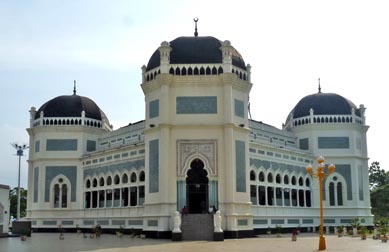 |
 |
The city is notable primarily for its traffic jams and a large collection of art deco buildings that in most other cities would be restored as architectural jewels but here are abandoned or converted into parking structures.
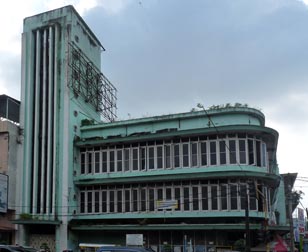 |
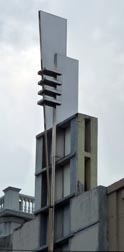 |
 |
 |
Throughout the day we are accosted by college girls in hijabs (Muslim head coverings) on assignment to interview a foreign tourist. Most have been searching all day for one. They all have the same list of silly questions (e.g., what are your favorite places in Sumatra? I don't know, we just got here), but they are very friendly and a few even attractive.
 |
We’ve hired a car and driver for four days. We start the next day with a trip to Bukit Lawang national park, home to a large orangutan population. It's about fifty miles distant, which translates into a two and a half hour drive each way. Just as we arrive, it starts raining (it's the rainy season). A guide tells us that high water prevents access to the orang feeding platform and that the only way to see apes is by hiring a private guide (namely him, at munificent fee). By now the rainy is getting serious, so we don ponchos and head out into the jungle. The problem, says the guide, is that the apes don't like to get wet either. During respite in the downpour, we get lucky: a big hairy orange gal comes down from the trees to accept our proffered bananas. She's got a young 'un, but he is more reticent. An excellent wildlife encounter and photo opportunity although he sold us a wolf ticket &mdash we later meet some folks who did go the feeding platform that day; it was open, but they didn't see a thing.)

We return to Medan for the night, and the next day leave for Lake Toba, five hours distant. Enroute we stop at the Paten factory where they make and sell such popular confections as Tengteng, Tingting, Tangtang, Tongtong, Tungtung, Pangpang, Pingping, Pongpong (but, alas, no Pingpong).
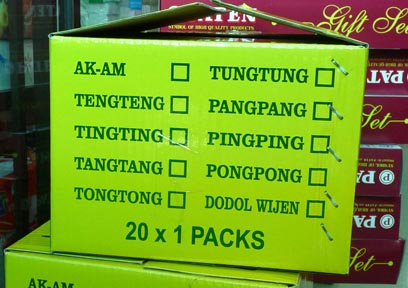 |
The area around the lake is home to the Batak people, a tribal ethnicity quite distinct from the Malay Muslim majority. Cannibals until succumbing to the entreaties of missionaries, they now practice an exotic blend of Christianity and pagan customs. Of particular interest are their elaborate tombs. On the road from Medan we encounter a Batak funeral in progress and are enthusiastically welcomed to join in line-dancing around the open coffin while a band plays jaunty tunes.
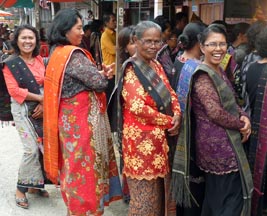 |
 |
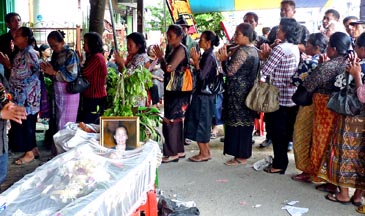 |
Lake Toba is a relic of a huge volcanic caldera that last erupted 70,000 years ago, an event that nearly caused the extinction of mankind. (Worldwide population is estimated to have dwindled to perhaps 10,000.) In the center of the lake an island has arisen, our destination. We drive to the lakeside town of Parapat, and then take a ferry to Tuk Tuk on the island opposite, where we check into the delightful Tabo Cottages.